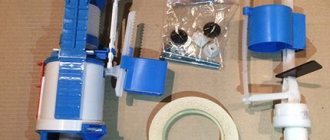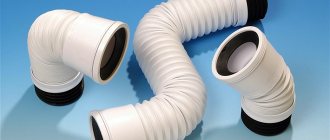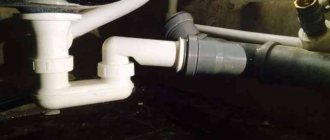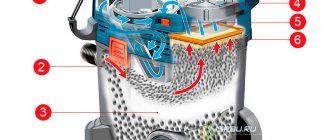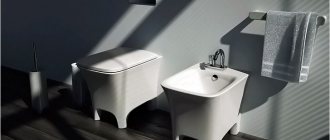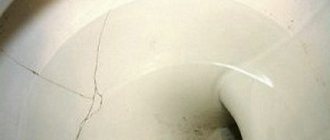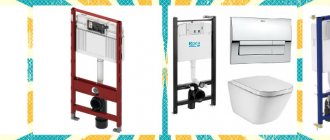When organizing a home, you have to solve a variety of issues, including choosing plumbing. It’s great if the bathtub and toilet are made in the same style. But if choosing a bathtub is quite simple, then when choosing a toilet the question often arises: which toilet is better with an oblique outlet or with a straight one. Release is an important factor in the separation of plumbing fixtures. Depending on the location of the connecting hole, it can be horizontal, vertical or oblique. In this article we will try to talk about the various nuances of choosing plumbing fixtures for a toilet room, and will dwell on the advantages and disadvantages of each type of product.
Oblique release
Oblique toilet outlet
The outlet device in such models is located with an angle maintained within 30-40°, and the most popular toilets with an oblique outlet in the “Brezhnevka” and “Khrushchev” buildings. In modern new buildings, a direct type connection is often found, but in this case it is quite acceptable to use plumbing fixtures that have an oblique outlet.
Model advantages:
- a very large selection of modifications;
- affordable cost of plumbing fixtures;
- maximum ease of self-connection;
- Possibility of connecting to a wide variety of output types.
Main disadvantages of the configuration:
- unsuitability of the design for connecting suspended models;
- a fairly high risk of sewer odors;
- the likelihood of splashes forming during draining.
In addition to the diversity of the model range and absolute versatility, the advantages of toilets with an oblique outlet include the ease of self-assembly of the device. The connection is made using a plastic adapter elbow, an eccentric, a flexible corrugated sleeve and waterproof silicone sealant.
Types of connecting elements
If it is impossible to directly connect the toilet to the sewer due to the design features, auxiliary materials are used - connecting pipes. In most cases, the following types are used:
- corrugation;
- eccentric cuffs;
- corners and elbows made of plastic;
- pipes of various materials, but plastic is preferable.
Connecting the toilet to the sewer with corrugated pipes is used if the alignment of the pipes is not maintained. The advantage of this type is the ability to install the product at an arbitrary angle.
The disadvantages of using corrugations to connect the toilet to the sewer include the large minimum length. If the distance between the pipes is about 12 cm, it is better to opt for other connecting components.
Eccentric cuffs outwardly look like 2 bends with shifted centers. Before purchasing the part, it is recommended to measure the offset between the sewer line and the toilet flush.
This data will allow you to choose the most suitable cuff model in the store. The disadvantage of the eccentric part is its short length, which implies the possibility of installation only with a small distance between the nozzles (up to 12 cm).
Bends and corners are installed in cases where the corrugation cannot be used for some reason. Their advantage compared to corrugation is that the wall is smooth on the inside, which significantly reduces the risk of blockages.
The main disadvantage is rigidity, which leads to leakage even with a slight misalignment. Plastic products can be cut to fit, unlike cast iron.
In most cases, steel pipes are used when there is a risk of failure of the water seal mechanism (find out what a water seal for sewerage is, its operating principles, what types there are, etc.). If the throughput of the riser is insufficient, liquid from the siphon will be drawn into it.
As a result, the water seal does not work, and the stench from the sewer enters the room. In such a situation, a pipe product with an automatic valve is connected to the riser or pipe connected to the toilet. When draining, a special valve opens and air enters, which prevents the water seal from breaking.
However, to implement such a function it is not necessary to use steel pipes. There are also eccentrics and adapters that give the pipeline similar properties. To ensure reliable connection, it is recommended to use sealant when using any type of connecting elements.
For these purposes, it is advisable to purchase a special waterproof product intended for plumbing fixtures. By loosening the rubber sealing collar, the sealant will prevent leakage.
Corrugated connection
As a rule, installation of a toilet with direct and oblique outlet is carried out using corrugation. It has an affordable price, can be bent in any direction and used as a temporary connecting element. When purchasing, you should focus on the length from the sewer outlet to the toilet outlet; the corrugation should be a third larger than this value.
What is a toilet flush? This is a drain hole that connects the apartment’s plumbing to the sewer system. There are three varieties - horizontal, vertical and oblique drain outlet.
Brief algorithm of actions:
- Coat the joint with silicone and insert the corrugation with the seal into the hole in the pipeline. It is advisable not to move it until the silicone-based product has completely dried.
- Place the toilet and check its stability. If the product wobbles, it is necessary to level the floor or install special stands.
- Insert the corrugation into the toilet pipe; there is no need to lubricate the connection with anything.
- Pour in a few liters of liquid, wait 1 minute, then make sure there are no leaks. If the connection leaks, you need to disconnect the corrugation, check the correct location of the seals and carefully reinstall it.
- If there are no leaks, you can mark the mounting points of the plumbing fixture with a pencil or marker.
- Secure the product so that it does not swing.
- Connect to sewer.
- After 2 hours, carry out testing by performing several drains. Wait 5 minutes, if the pipe does not leak, you can begin installing the tank and other elements.
- Lubricate the joint with sealant from the outside to prevent future leaks.
If a small leak (a few drops) was detected during the last test, all liquid must be completely removed and the corrugation removed. Then apply silicone again to the elastic band of the product and install it on the toilet pipe.
Find out what you need to do if the toilet tank suddenly starts leaking: 9 reasons why it is leaking and video instructions for repair.
Horizontal
Models of toilets with a horizontal outlet can be installed in the presence of a sewer pipe with an outlet at an oblique angle, but using special pipes. The device is installed close to the wall, which helps save space and make the appearance of such a plumbing fixture as aesthetically pleasing as possible. Standard cuffs are used to connect the toilet.
Model advantages
- guaranteed maintainability;
- affordable cost of plumbing fixtures;
- quite decent performance characteristics;
- Possibility of installation to corner devices with oblique outlet.
Main disadvantages of the configuration:
- the need to adapt corrugated adapters;
- the likelihood of reinstalling the sewer pipe;
- certain complexity of self-installation.
Today, floor-standing, suspended and attached models are equipped with horizontal outlets. The parallel arrangement is also characterized by some disadvantages, including difficulties during self-installation, the risk of frequent blockages and leaks in the areas where the plumbing fixture meets the sewer system.
Classifications of sanitary devices
Progress does not stand still - manufacturers systematically bring new varieties to the market. They can be classified into several groups based on criteria.
Depending on the location of fixation, it is customary to distinguish the following categories:
- Floor-standing.
- Hanging.
Manufacturers also make allowances for the age of their customers and offer:
- Sanitary products for adults.
- Children's options.
The bowl in the equipment may differ in shape:
- Funnel-shaped.
- Rounded.
- Design form (in cases where custom production is acceptable).
The drainage system has differences, and manufacturers have gone as far as possible in this matter. The following options are available:
- Single-mode. When you press the button, the tank is completely emptied.
- Dual mode. You can pour out all the water or only part of it.
- Contactless. Flushing is carried out automatically. This is the most expensive option.
A common question is the availability of side release devices. The reasonableness of such a question occurs only if you have to deal with very small dimensions of the bathroom. The ingenuity of our people is truly limitless, and the side release is proof of this. The thing is that if you place the toilet on its side, you can easily free up the space needed to install a washing machine.
So, such varieties have not yet gone on official sale today, but if you wish, you can literally do everything with your own hands. To ensure lateral descent, adapters can be used. On horizontal sections, you should make a 90-degree turn out of two 45 degrees, although some recommend 90 degrees at once, just to ensure a slope.
Universal
A feature of the functional universal design of the toilet outlet is the removal of sewage and domestic water using various elements that provide a transition to the wall or floor. On toilets with a universal outlet type, the outlet pipe is located in a horizontal position at the rear of the structure. The price for such models is usually noticeably higher.
Model advantages:
- operational comfort;
- absence of unpleasant sewer odors;
- maximum convenience of independent repair work;
- Possibility of use with different sewerage options.
Main disadvantages of the configuration:
- the need to use adapters for installation in the floor or riser;
- high cost of imported sanitary products;
- some maintenance problems.
Due to their design features, plumbing fixtures with a universal outlet option are successfully used in sewer systems of various types. Thanks to correctly selected adapters and the ability to make an easy, quickest independent connection, universal releases are in high demand.
Main types of toilet release
Types of models by flush
Based on flushing, toilets are divided into two types: direct flush and circular.
- Direct flush . The advantages of this model are its low price. Despite the fact that the design of this model has a long service life, flushing occurs on one side of the bowl, poorly rinsing the rest of the surface, and produces noise and splashing.
- Circular flush . Water comes from different sides, reaching the surface of the bowl without creating much noise. The surface of the toilet bowl is washed up to 95%.
You can purchase a model with a non-standard drain design. It is designed to wash the entire inner perimeter of the bowl. The bowl is filled with water and then quickly washed off. The disadvantage of this model is that it uses too much water. A standard drain of water consumes about 6 liters, but this design will overspend more than 8 liters. To reduce consumption by half, you can install a system with full and economical flow.
Release to the floor
The vertical location of the outlet part allows the toilet to be installed even in conditions of insufficient free space, in small plumbing rooms. The most important difference in the configuration is the presence of a siphon and pipe already built into the product itself. Installation of these models can be done in a variety of ways, which is explained by the lack of connection to the wall.
Model advantages:
- optimal design for a private home;
- Possibility of installation almost anywhere;
- masking the sewer line under the floor;
- maximum convenience of inspection and repair of the output part.
Main disadvantages of the configuration:
- inappropriate layout of the sewer system;
- high cost of professional repair and installation services;
- The cost of the plumbing itself is quite high.
The undeniable advantages of the model range with floor outlet include the ease of choosing a place for installation, installation compactness, the availability of sufficient free space for the installation of additional plumbing fixtures and furniture, high efficiency of the flushing system, the absence of water splashes during the draining process, as well as guaranteed strength and reliability designs.
Criterias of choice
Before purchasing a toilet, it would be a good idea to consult with a plumber, who will subsequently be entrusted with installing the device.
It is necessary to pay attention to the fact that the model is proportionate to the area of the bathroom. You should not purchase a toilet that takes up more than two-thirds of the free space, which is usually modest in terms of the room’s parameters. Comfort during use is not the least important criterion.
You should go to a plumbing store knowing what the diameter of the drain hole should be. If it does not correspond to the sewer drain pipe, you will have to worry about purchasing a connecting collar with corrugation and sealant.
The appearance of the toilet is important. A color scheme that matches the overall design of the bathroom, the shape of the rim, the bowl - everything matters when arranging a toilet room.
Wall-hung toilet
Installations today do not fall into the category of common toilet models, so connecting them is often difficult. Wall-hung plumbing fixtures are installed using a support structure in the form of a metal frame to secure the flush cistern and bowl. Installation and finishing make it possible to make only the toilet bowl and cistern button visible, and the piping system of frame and block structures is covered with finishing materials.
Model advantages:
- operational comfort;
- almost silent operation;
- absence of unpresentable appearance of risers;
- the ability to select a device to match the overall style.
Main disadvantages of the configuration:
- difficulty in choosing the optimal connection scheme;
- high cost of plumbing fixtures;
- complexity of audit and maintenance.
Each kit is complemented by a detailed connection diagram to the sewer pipe, and installation problems may be caused by the location of the toilet outlet, which is completely incompatible with the inlet in the tee. Under such conditions, a suspended model is connected to the sewer network using a flexible pipe. Corrugation allows you to connect elements located in different planes, but also lengthens the outlet section, which is not always necessary when installing an installation.
Customer Reviews
Nikita, Moscow : “The quality and ease of use justifies the money spent on a hanging model. Beautiful, compact, rimless, hidden installation. It looks stylish, it’s pleasant to use, there’s now a lot of space in the bathroom.”
Vladimir, Moscow : “At this price, an excellent toilet. Almost no tools were required for installation. Before purchasing, I read that the included gaskets for the tank must be changed immediately to prevent it from leaking. That's what I did, and I didn't tighten the fasteners all the way. There are no problems. Disadvantage: the lid must be purchased separately, the toilet seat is modest in size.”
Which release is better?
The most popular in the Russian Federation and the post-Soviet space are toilets with a standard oblique outlet. In accordance with all currently valid standards and requirements for the preparation of standard design documentation for the arrangement of sewer networks in residential and administrative buildings, the pipes are intended for the installation of plumbing fixtures that have an oblique type outlet. The optimal option is considered to be not only models that meet these requirements, but also devices with a universal connection type. Such toilets provide complete freedom in planning the plumbing room.
Modern installations deserve special attention. Wall-hung toilets provide maximum hygiene and stylish room design, but are quite difficult to install and are installed in accordance with certain rules, so it is advisable to refrain from installing them yourself. Thus, the waste part of the toilet must strictly correspond to the type of location of the sewer pipe outlet in the plumbing unit, but if necessary, it is always possible to use models with a universal drain outlet option.
Distances
It’s good for those who have a large room allocated for a bathroom or toilet. If yours is not so large, you need to know the minimum tolerances for the distance from the toilet to nearby “structures” and devices.
Distance from the toilet to the wall: according to standards - at least 25 cm
- There should be at least 25 cm between the bidet and the toilet.
- There must be at least 60 cm of free space in front. That is, the distance from the edge of the bowl to the door or wall in front is 60 cm or more.
- There should be at least 25 cm of free space on the sides. This is not enough, but tolerable. Comfortable distance - 35 cm.
Now you draw a plan of your bathroom, mark the minimum distances and see what size toilet will fit into your toilet. So it's simple.
Manufacturers
The best toilets with oblique outlet are made by many Russian and foreign ones, Jika and others.
Katun toilets are suitable for premises of any purpose: residential buildings, offices, shopping centers, catering establishments. They are designed for long-term use.
The Tom compact toilet, produced by UK Universal LLC, has a funnel-shaped bowl and takes up minimal space in the room. This type of sanitary ware is equipped with a solid cast shelf and a high cistern.
The Czech brand Jika leads the ranking of the best imported manufacturers . Its line includes toilets with oblique outlet Vega and Lyra.
- Jika Vega is a floor-standing model equipped with a tank. Made of glazed porcelain, flushing water is supplied from below.
- Jika Lyra is a compact toilet with a funnel-shaped flush. The price of this model is quite attractive, considering the configuration.
Another popular model is Ifo Frisk . This is a Swedish floor-mounted toilet made of earthenware. The plumbing is equipped with a microlift, which makes it more comfortable to use.
The domestic brand Santek offers standard models of toilets with an oblique outlet, equipped with an anti-splash function.
Plumbing fixtures with an oblique socket are available in the lines of Swedish, Italian, and German manufacturers.
Non-standard toilet sizes: models for the disabled and devices with additional functions
For people of large build, appropriate toilet sizes are selected, which are characterized by increased dimensions. Such options are intended for people with a large weight or a height of 190 cm. When choosing a model, you should give preference to an option that can withstand increased load. Often, enlarged toilet models are designed to weigh 600-650 kg. The standards for the height of the toilet from the floor in this case will differ from the generally accepted ones and usually reach 65-70 cm, the length of the models is from 70 cm, and the width is 40 cm or more.
Helpful advice! If retail outlets do not find the optimal toilet size corresponding to the area of the room, you can make a piece of plumbing fixtures to order, taking into account the necessary parameters.
Most often, non-standard toilets are made to order for people with disabilities. In this case, it is necessary that the device not only be larger in size, but also be equipped with special handrails and a seat. The height of such models is 15-20 cm more than standard options. If the toilet is used by a wheelchair user, the height of the seat should not exceed the dimensions of the wheelchair. Typically this parameter is 50-60 cm. The same toilet dimensions are recommended for use by older people.
For people with disabilities, toilets of non-standard sizes and characteristics are ordered
Toilets with a built-in bidet may also have non-standard sizes. In most cases, these models are long due to their special elongated shape, because the shower head is conveniently mounted on the headband. The toilet cistern with bidet also has larger dimensions compared to standard ones. The length of the models is usually about 70 cm, and the width is 40-41 cm. The suspension system has smaller dimensions: width – 29-36 cm, and length – 52-60 cm.
Place of installation of drain tanks and their design
According to the installation method, drain tanks are mounted as follows:
- The drain tanks of the “compact” system are attached to the bowl. This is the most popular option among those used. The advantage is easy access for repairs and compactness.
- In Soviet apartments you can find a hanging cistern. These are already relics of a past era or stylization of the interior for ancient times. The mounting location is the wall above the toilet, which is connected to the bowl-pipe.
- There is also the option of a tank built into the wall, or as it is now called an installation system. Such tanks are usually used with models that do not stand on the floor, but are hung on the wall. At the same time, the tank is most reliably protected in this case.
- And the last, least common - without a cistern. Here the toilet bowl is flushed directly from the water supply system.
The design of the cistern consists of the following elements:
- drain fittings designed to control the discharge of water by shutting off the drain valve. Because of it, there is water in the tank for later draining.
- fittings for water supply, the tank is attached to the water supply system.
- an overflow mechanism that acts as a fuse in the tank system. With continuous supply from the water supply, the mechanism begins to discharge excess moisture.
Construction options
Basically, toilets with an oblique outlet can be separate or monoblock.
- When the bowl and tank are located separately, they are connected using a pipe. The tank can be suspended from the wall at any height or built into the wall, which reduces noise levels. When flushing, the suspended design provides better flushing of the toilet bowl, due to the greater energy of the water velocity acquired when passing through the vertical drain. Toilets with hidden tanks allow you to visually expand the sanitary room.
- With a monoblock toilet with a flush cistern, they are a monolithic structure, the installation of which is much easier to carry out. Such toilets have a more modern look and visually increase the space of the toilet room. The low location of the tank makes it easier to care for monoblock toilets. The disadvantage is its higher cost. In addition, during installation it is necessary to take into account that a monolithic structure requires a little more space.
This is interesting: Corner toilet: important selection criteria, installation sequence (26 photos)
No splashing
Does the release and splashing in the toilet have any connection? Absolutely not. One does not affect the other in any way. Everything depends entirely on the shape of the bowl.
There are three types of form:
- With shelves;
- With slopes;
- Funnel-shaped.
In the case of the latter type, the drain hole is in the center. If the shape is sloped, then the drain is closer to one of the sides. And shelves are used extremely rarely in our time, since they have serious disadvantages. Because of them, they cannot impose competition on other species.
Choose a form based on your own needs and desires. They are individual, so we cannot give specific recommendations on this matter.
Main differences and advantages
If we talk about toilets with a vertical or horizontal outlet pipe, their connection point to the sewer must be located at a strictly defined level. This often causes a lot of inconvenience during installation, and even makes it impossible without altering the sewer line. A floor-standing toilet with an oblique outlet does not have this drawback. The drain pipe in relation to it can be located at an angle from 0 to 35 degrees, which gives more space for maneuver during installation. In addition, this type of plumbing products has the following advantages:
- due to weak resistance, sewage flows into the pipe much more easily;
- such a system is much less likely to become clogged;
- after installation, two elbows are formed, each of which will be at an angle of 45 degrees. This significantly increases efficiency and improves the water seal.
Toilet with oblique outlet
These advantages have become the reason for the widespread and great popularity of this type of toilet. Just look at any specialized store to be convinced that 80% of the models presented have an oblique exit. Only 2-3 products out of 10 will be in a different design.
How to supply water to the tank
A tank is a container that holds water for flushing. Without supplying water pipes to this device, the toilet simply will not be able to perform its main functions - flushing animal products.
Usually, water is supplied to it either from the side or from below. The most common method is the approach from the right or left, that is, the lateral method.
The lower supply is less common, since in this case it is more difficult to attach. But when supplying from below, you cannot hear water entering the tank, which cannot be said about the first method.
